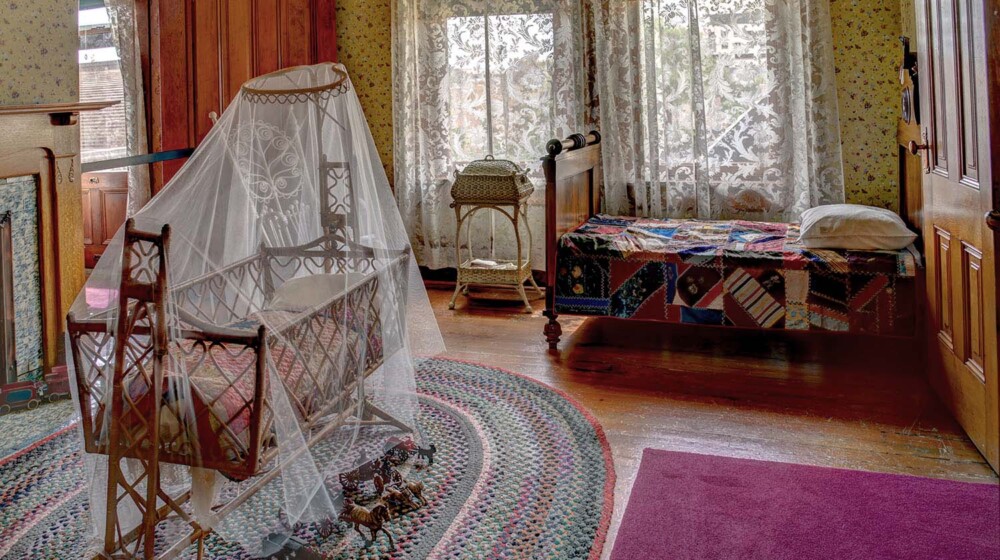The Nursery
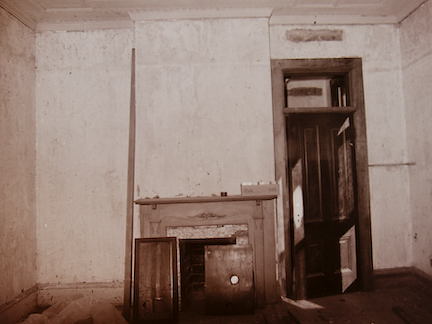 The original George F. Barber plan for this room had the fireplace on the west wall instead of the passage to the main bedroom, and the closet on the opposite corner on that wall. While the home was a boarding house, the adjoining door had been closed off, gas pipes had been added to the fireplace, and a sink was installed by the door to the back staircase. This is the only fireplace in the House to not have an overmantle, though based on holes in the wall found during restoration, it may have originally had one.
The original George F. Barber plan for this room had the fireplace on the west wall instead of the passage to the main bedroom, and the closet on the opposite corner on that wall. While the home was a boarding house, the adjoining door had been closed off, gas pipes had been added to the fireplace, and a sink was installed by the door to the back staircase. This is the only fireplace in the House to not have an overmantle, though based on holes in the wall found during restoration, it may have originally had one.
During a 1977 interview, Jesse Jean (Higley) Lane indicated that this was her room. She recalled that there were rosebuds on the wallpaper, and that the room was furnished with a brass bed, dressing table, a chest of drawers, a blanket chest, a rocker and a straight chair. Jesse Jean also told of sneaking her pet deer, named “Bunny,” up the stairs to her room, and always struggled to get Bunny back downstairs.
Here are a few of our most-asked-about artifacts from the Nursery, in alphabetical order (if there are any we’ve missed that you’d like to know more about, please let us know):
-
Cast-Iron Toys
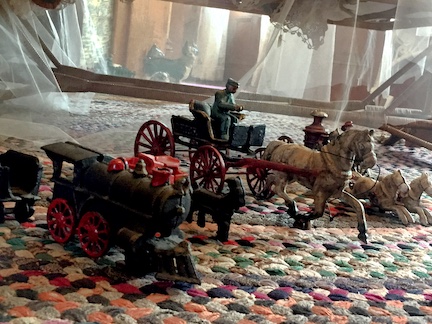 During the Industrial Revolution, manufacturers were able to mass produce inexpensive, cast-iron toys like these. The most popular cast-iron toys were vehicles (like the antiques we have in the Nursery) and banks (like the modern replica we have in the Nursery touch basket). They were painted in bright colors, using paint made with lead.
During the Industrial Revolution, manufacturers were able to mass produce inexpensive, cast-iron toys like these. The most popular cast-iron toys were vehicles (like the antiques we have in the Nursery) and banks (like the modern replica we have in the Nursery touch basket). They were painted in bright colors, using paint made with lead.
-
Closet
Closets started becoming more common in homes towards the end of the 19th They were used for general storage as well as clothing storage, which is why they’re often found in public rooms like parlors (like the Family Parlor in Rosson House). People used trunks and wardrobes for clothing storage before closets became popular, and hung clothing on hooks in closets before hangars were widely used.
-
Cradle
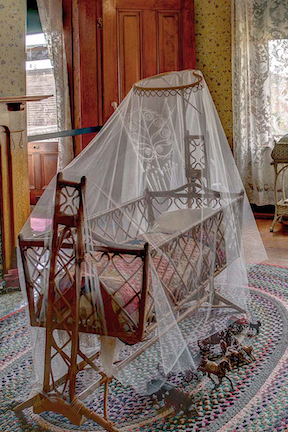 Made of wicker with a removable halo or crown to attach netting to that would keep insects away from the baby, it has a trestle base with a latch to prevent the cradle from rocking when needed. The wicker had been painted at some point, but was restored to its natural finish in 1986. Side note: The cradle was donated by the same family who donated the picture of the baby above the mantle in this room, but we don’t know who the baby was nor if this was her/his cradle.
Made of wicker with a removable halo or crown to attach netting to that would keep insects away from the baby, it has a trestle base with a latch to prevent the cradle from rocking when needed. The wicker had been painted at some point, but was restored to its natural finish in 1986. Side note: The cradle was donated by the same family who donated the picture of the baby above the mantle in this room, but we don’t know who the baby was nor if this was her/his cradle.
-
Teddy Bear
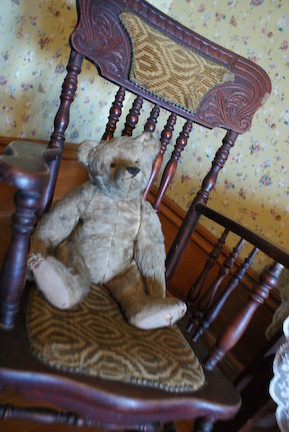 This stuffed teddy bear (c1909) has jointed arms and legs, which makes if most likely a Steiff bear, though it is missing the Steiff trademark button in its ear. First made in 1902, Steiff bears are highly collectable and were the first stuffed bears made with arms and legs that moved. In 1906, the bears were sold in the US under the name “Teddy Bear, nicknamed after President “Teddy” Roosevelt.
This stuffed teddy bear (c1909) has jointed arms and legs, which makes if most likely a Steiff bear, though it is missing the Steiff trademark button in its ear. First made in 1902, Steiff bears are highly collectable and were the first stuffed bears made with arms and legs that moved. In 1906, the bears were sold in the US under the name “Teddy Bear, nicknamed after President “Teddy” Roosevelt.
-
Quilt
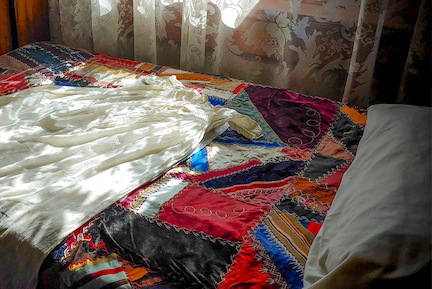 This crazy quilt (c1875-1900) is made of satin, brocade, velvet, and velveteen ribbon in bright, jewel-like colors with playful stitching designs throughout. The term “crazy quilt” refers to the irregular shapes and stitching, along with the wide variety of materials used to construct the quilt. Though it looks haphazard, these types of quilts were carefully planned.
This crazy quilt (c1875-1900) is made of satin, brocade, velvet, and velveteen ribbon in bright, jewel-like colors with playful stitching designs throughout. The term “crazy quilt” refers to the irregular shapes and stitching, along with the wide variety of materials used to construct the quilt. Though it looks haphazard, these types of quilts were carefully planned.
You can see all of the quilts in our collection at The Quilt Index website. Join us for a Storytime at the Square where we read The Quilt Story, by Tony Johnston. Visit our History at Home webpage to design your own crazy quilt. Learn about school at the turn-of-the-century from our blog articles, Back to School and School’s Out. Discover more from our blog about Victorian Era toys, and Victorian Era pets like Bunny.
La Habitación de Niños
 El plan original de George F. Barber para esta habitación tenía la chimenea en la pared oeste en lugar de en camino a la recámara principal, y el armario en la esquina opuesta de esa pared. Mientras la casa era una casa de huéspedes, la puerta contigua se clausuró, tubería de gas se agregó a la chimenea, y un lavabo se instaló enseguida de la puerta a las escaleras traseras. Esta es la única chimenea en la casa que no cuenta con un estante, aunque basándonos en los agujeros en la pared que se encontraron durante la restauración, es posible que originalmente tuviera uno.
El plan original de George F. Barber para esta habitación tenía la chimenea en la pared oeste en lugar de en camino a la recámara principal, y el armario en la esquina opuesta de esa pared. Mientras la casa era una casa de huéspedes, la puerta contigua se clausuró, tubería de gas se agregó a la chimenea, y un lavabo se instaló enseguida de la puerta a las escaleras traseras. Esta es la única chimenea en la casa que no cuenta con un estante, aunque basándonos en los agujeros en la pared que se encontraron durante la restauración, es posible que originalmente tuviera uno.
Durante una entrevista en 1977, Jesse Jean (Higley) Lane indicó que esta era su habitación. Ella recordó que había rosas en el papel tapiz, y que la habitación tenía una cama de latón, un vestidor, una cajonera, un baúl para frazadas, una silla mecedora, y una silla regular. Jesse Jean también contó acerca de meter a escondidas a su venado mascota, llamado “Bunny,” por las escaleras a su recámara, y siempre era un lío bajar a Bunny.
Aquí hay algunos de nuestros artefactos de la habitación de niños de los cuales recibimos más preguntas, en orden alfabético (Si hay alguno que no hemos incluido del cual quisieras saber más, háznoslo saber).
-
Armario
Los armarios se hicieron más comunes en los hogares al final del siglo 19. Se utilizaban como almacenamiento general, al igual que para guardar ropa, razón por la cual comúnmente se encontraban en cuartos públicos como salas (como la sala familiar en la Casa Rosson). La gente utilizaba baúles y guardarropas para guardar su ropa antes de que los armarios o closets se hicieran populares, y colgaban la ropa de pequeñas perchas antes de que los ganchos se utilizaran ampliamente.
-
Cuna
 Hecha de mimbre con un halo o corona removible para sujetar una malla que mantiene a los insectos lejos del bebé, tiene un bastidor en la base con un cerrojo para prevenir que la cuna se mesa cuando era necesario. El mimbre estaba pintado en algún punto, pero fue restaurado a su estado original en 1986. Nota: La cuna fue donada por la misma familia eye donó la fotografía del bebé sobre el estante de la chimenea en esta habitación, pero no sabemos quién es ese bebé o si la cuna le perteneció.
Hecha de mimbre con un halo o corona removible para sujetar una malla que mantiene a los insectos lejos del bebé, tiene un bastidor en la base con un cerrojo para prevenir que la cuna se mesa cuando era necesario. El mimbre estaba pintado en algún punto, pero fue restaurado a su estado original en 1986. Nota: La cuna fue donada por la misma familia eye donó la fotografía del bebé sobre el estante de la chimenea en esta habitación, pero no sabemos quién es ese bebé o si la cuna le perteneció.
-
Edredón
 Este edredón (c.1875-1900) alocado está hecho de satín, brocado, terciopelo, y listón de pana en colores brillantes con diseños alegres de costuras por todos lados. El término “edredón alocado” se refiere a las formas y costuras irregulares, al igual que la variedad de materiales utilizados para construir el edredón. Aunque parece ser hecho al azar, este tipo de edredones eran planeados cuidadosamente.
Este edredón (c.1875-1900) alocado está hecho de satín, brocado, terciopelo, y listón de pana en colores brillantes con diseños alegres de costuras por todos lados. El término “edredón alocado” se refiere a las formas y costuras irregulares, al igual que la variedad de materiales utilizados para construir el edredón. Aunque parece ser hecho al azar, este tipo de edredones eran planeados cuidadosamente.
-
Juguetes de Hierro Fundido
 Durante la revolución industrial, During the Industrial Revolution, los fabricantes pudieron producir en masa juguetes económicos de hierro fundido como estos. Los juguetes de hierro fundido más populares eran los vehículos (como los antiguos que tenemos en esta habitación) y bancos/monederos (como la réplica moderna que tenemos en la canasta táctil). Estaban pintados con colores brillantes, utilizando pintura hecha con plomo.
Durante la revolución industrial, During the Industrial Revolution, los fabricantes pudieron producir en masa juguetes económicos de hierro fundido como estos. Los juguetes de hierro fundido más populares eran los vehículos (como los antiguos que tenemos en esta habitación) y bancos/monederos (como la réplica moderna que tenemos en la canasta táctil). Estaban pintados con colores brillantes, utilizando pintura hecha con plomo.
-
Oso Teddy
 Este oso teddy (c. 1909) tiene brazos y piernas articuladas, lo que lo hace muy probablemente un oso Steiff, aunque le hace falta el botón de la marca comercial Steiff en su oreja. Producidos por primera vez en 1902, los osos Steiff son objetos de colección y fueron los primeros osos de felpa hechos con brazos y piernas articulados. En 1906, los osos comenzaron a venderse en los Estados Unidos con el nombre “Oso Teddy,” apodo que se tomó del Presidente “Teddy” Roosevelt.
Este oso teddy (c. 1909) tiene brazos y piernas articuladas, lo que lo hace muy probablemente un oso Steiff, aunque le hace falta el botón de la marca comercial Steiff en su oreja. Producidos por primera vez en 1902, los osos Steiff son objetos de colección y fueron los primeros osos de felpa hechos con brazos y piernas articulados. En 1906, los osos comenzaron a venderse en los Estados Unidos con el nombre “Oso Teddy,” apodo que se tomó del Presidente “Teddy” Roosevelt.
Puedes ver todos los edredones de nuestra colección en la página web El Índice del Edredón (The Quilt Index). Acompáñanos a la hora del cuento en la plaza, en donde leeremos La Historia del Edredón (The Quilt Story), de Tony Johnston. Visita nuestra página de Historia en casa para diseñar tu propio edredón alocado. Aprende acerca de la escuela a principios del siglo 20 con nuestros artículos de blog, De Regreso a Clases y Se Acabaron las Clases. Descubre más con nuestro blog acerca de juguetes de la era Victoriana, y mascotas de la era Victoriana, como Bunny.
Siguiente Página: La Recámara Norte Volver a la Página Principal
